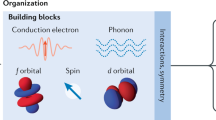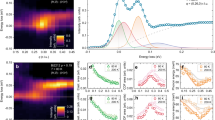Abstract
At quantum critical points (QCPs) quantum fluctuations exist on all length scales, from microscopic to macroscopic, which, remarkably, can be observed at finite temperatures—the regime to which all experiments are necessarily confined. But how high in temperature can the effects of quantum criticality persist? That is, can physical observables be described in terms of universal scaling functions originating from the QCPs? We answer these questions by examining exact solutions of models of systems with strong electronic correlations and find that QCPs can influence physical properties at surprisingly high temperatures. As a powerful illustration of quantum criticality, we predict that the zero-temperature superfluid density, ρs(0), and the transition temperature, Tc, of the high-temperature copper oxide superconductors are related by Tc∝ρs(0)y, where the exponent y is different at the two edges of the superconducting dome, signifying the presence of the respective QCPs. This relationship can be tested in high-quality crystals.
This is a preview of subscription content, access via your institution
Access options
Subscribe to this journal
Receive 12 print issues and online access
$209.00 per year
only $17.42 per issue
Buy this article
- Purchase on Springer Link
- Instant access to full article PDF
Prices may be subject to local taxes which are calculated during checkout




Similar content being viewed by others
References
Pfeuty, P. & Elliott, R. J. The Ising model with a transverse field. II. Ground state properties. J. Phys. C 4, 2370–2385 (1971).
Young, A. P. Quantum effects in the renormalization group approach to phase transitions. J. Phys. C 8, L309–L313 (1975).
Hertz, J. A. Quantum critical phenomena. Phys. Rev. B 14, 1165–1184 (1976).
Chakravarty, S., Halperin, B. I. & Nelson, D. R. Two-dimensional quantum Heisenberg antiferromagnet at low temperatures. Phys. Rev. B 39, 2344–2371 (1989).
Millis, A. J. Effect of a nonzero temperature on quantum critical points in itinerant fermion systems. Phys. Rev. B 48, 7183–7196 (1993).
Chubukov, A. V., Sachdev, S. & Jinwu, Y. Theory of two-dimensional quantum Heisenberg antiferromagnets with a nearly critical ground state. Phys. Rev. B 49, 11919–11961 (1994).
Coleman, P. & Schofield, A. J. Quantum criticality. Nature 433, 226–229 (2005).
Pfeuty, P. The one-dimensional Ising model with a transverse field. Ann. Phys. (NY) 57, 79–90 (1970).
Privman, V. & Fisher, M. E. Universal critical amplitudes in finite-size scaling. Phys. Rev. B 30, 322–327 (1984).
Affleck, I. Universal term in the free energy at a critical point and the conformal anomaly. Phys. Rev. Lett. 56, 746–748 (1986).
Blöte, H. W. J., Cardy, J. L. & Nightingale, M. P. Conformal invariance, the central charge, and universal finite-size amplitudes at criticality. Phys. Rev. Lett. 56, 742–745 (1986).
Hirsch, J. E. & Mazenko, G. F. Renormalization-group transformation for quantum lattice systems at zero temperature. Phys. Rev. B 19, 2656–2663 (1979).
Chubukov, A. V., Sachdev, S. & Sokol, A. Universal behavior of the spin-echo decay rate in La2CuO4 . Phys. Rev. B 49, 9052–9056 (1994).
Sachdev, S. Quantum Phase Transitions (Cambridge Univ. Press, Cambridge, 1999).
Fisher, M. P. A., Weichman, P. B., Grinstein, G. & Fisher, D. S. Boson localization and the superfluid-insulator transition. Phys. Rev. B 40, 546–570 (1989).
Emery, V. J. & Kivelson, S. A. Importance of phase fluctuations in superconductors with small superfluid density. Nature 374, 434–437 (1995).
Balents, L., Fisher, M. P. A. & Nayak, C. Nodal liquid theory of the pseudo-gap phase of high-Tc superconductors. Int. J. Mod. Phys. B 12, 1033–1068 (1998).
Liang, R., Bonn, D. A. & Hardy, W. Lower critical field and superfluid density in highly underdoped YBa2Cu3O6+x single crystals. Phys. Rev. Lett. 94, 117001 (2005).
Niedermayer, C. et al. Muon spin rotation study of the correlation between Tc andn s /m* in overdoped Tl2Ba2CuO6+δ . Phys. Rev. Lett. 71, 1764–1767 (1993).
Uemura, Y. J. et al. Magnetic-field penetration depth in Tl2Ba2CuO6+δ in the overdoped regime. Nature 364, 605–607 (1993).
Bernhard, C. et al. Magnetic penetration depth and condensate density of cuprate high-Tc superconductors determined by muon-spin-rotation experiments. Phys. Rev. B 52, 10488–10498 (1995).
Panagopoulos, C. et al. Superfluid response in monolayer high-Tc cuprates. Phys. Rev. B 67, 220502 (2003).
Belitz, D., Kirkpatrick, T. R. & Rollbuhler, J. Breakdown of the perturbative renormalization group at certain quantum critical points. Phys. Rev. Lett. 93, 155701 (2004).
Rønnow, H. M. et al. Quantum phase transition of a magnet in a spin bath. Science 308, 389–392 (2005).
Anderson, P. W. In praise of unstable fixed points: the way things actually work. Physica B 318, 28–32 (2002).
Phillips, P. & Chamon, C. Breakdown of one-paramater scaling in quantum critical scenarios for the high-temperature copper-oxide superconductors. http://arxiv.org/abs/cond-mat/0412179 (2004).
Fradkin, E. & Susskind, L. Order and disorder in gauge systems and magnets. Phys. Rev. D 17, 2637–2658 (1978).
Wei, T.-C., Das, D., Mukhopadyay, S., Vishveshwara, S. & Goldbart, P. M. Global entanglement and quantum criticality in spin chains. Phys, Rev. A 71, 060305 (2005).
Castro Neto, A. H. & Fradkin, E. The thermodynamics of quantum systems and generalizations of Zamolodchikov’s c-theorem. Nucl. Phys. B 400, 525–546 (1993).
Author information
Authors and Affiliations
Corresponding author
Ethics declarations
Competing interests
The authors declare no competing financial interests.
Rights and permissions
About this article
Cite this article
Kopp, A., Chakravarty, S. Criticality in correlated quantum matter. Nature Phys 1, 53–56 (2005). https://doi.org/10.1038/nphys105
Received:
Revised:
Accepted:
Published:
Issue Date:
DOI: https://doi.org/10.1038/nphys105
This article is cited by
-
Multi-critical topological transition at quantum criticality
Scientific Reports (2021)
-
Reconstructing the quantum critical fan of strongly correlated systems using quantum correlations
Nature Communications (2019)
-
Multipartite Entanglement at Finite Temperature
Scientific Reports (2018)
-
Finite-temperature scaling of trace distance discord near criticality in spin diamond structure
Scientific Reports (2017)
-
Quantum correlation and quantum phase transition in the one-dimensional extended Ising model
Quantum Information Processing (2017)



